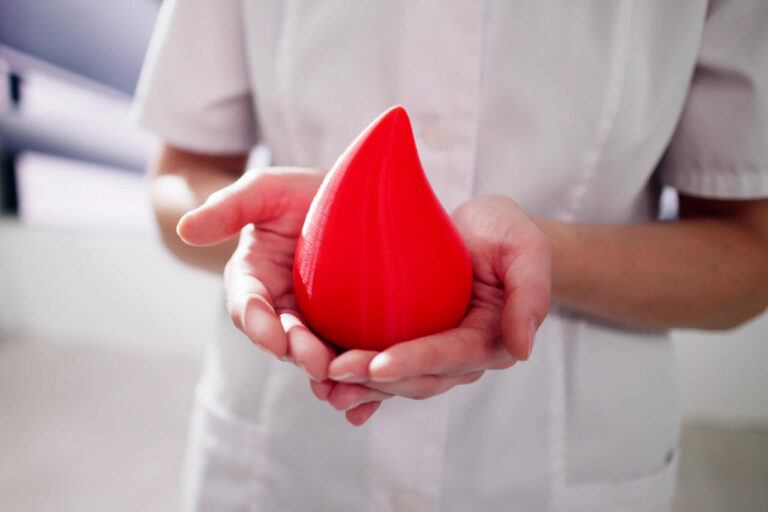
Alprolix injection is a long-acting coagulation factor IX (recombinant) used to treat hemophilia B in children and adults. In this article, you will learn about its mechanism of action, dosage, side effects, cost, and more.
Get Financial Assistance
Before Using Alprolix
Before you receive your first dose of Alprolix for hemophilia B, inform your provider if you:
- Are pregnant or planning to get pregnant
- Are breastfeeding
- Have proteins called inhibitors, which can stop this medication from working well
Warnings and Precautions
Allergic Reactions
Alprolix injections may cause allergic reactions, which can be fatal. Seek emergency medical care if you experience:
- Hives
- Breathing difficulty
- Swelling in the face or throat
Inhibitor (Antibody) Production
In some cases, your body can produce proteins called “inhibitors” or antibodies, which can prevent this medication from working as intended.
Your healthcare provider will likely order tests to measure Factor IX inhibitors in your blood if:
- Factor IX level does not increase as expected after starting treatment
- Bleeding does not stop with an appropriate dose
Complications Due to Blocked Blood Vessels
Factor IX products may increase the risk of a blood vessel being blocked by a circulating blood clot. The risk may be higher if you receive continuous infusions through a large vein.
Thus, Alprolix is administered as a bolus infusion (rapid injection) over several minutes.
Alprolix Introduction and Uses
Alprolix injection is a brand-name prescription product. It contains the active ingredient “recombinant coagulation factor IX”, also called eftrenonacog alfa.
This medication belongs to a class known as coagulation factors or hemostatics.
A healthcare provider may prescribe this medication for children and adults with hemophilia B to:
- Control and prevent bleeding episodes
- Prevent bleeding during surgery
- Reduce the frequency of bleeding episodes
In people with hemophilia B, blood doesn’t clot properly, as they have a coagulation factor IX deficiency. Factor IX deficiency causes abnormal bleeding after injuries or surgery. Severe hemophilia B may cause spontaneous joint or muscle bleeds.
Alprolix should not be used to remove inhibitors in people with hemophilia B.
The US FDA approved Alprolix (then made by Biogen Idec) to treat hemophilia B in 2014. Currently, Bioverativ Therapeutics Inc., a Sanofi Company, makes this medication.
This medication comes as a sterile white to off-white powder that must be reconstituted into a solution for intravenous (IV) injection. There are three components in an Alprolix kit:
- One single-dose glass vial, which contains powder of factor IX and the Fc molecule
- One prefilled syringe containing 5 ml liquid, also called a diluent
- One reconstitution device (which is used to mix the powder and liquid before administration)
The following strengths are available in the U.S.:
- 250 IU
- 500 IU
- 1,000 IU
- 2,000 IU
- 3,000 IU
- 4,000 IU
Get Copay Assistance Now
Alprolix Mechanism of Action
This medication works by replacing missing coagulation factor IX in people with hemophilia B. It comprises two components:
- Factor IX (helps stop bleeds)
- Fc Molecule (helps factor IX recirculate in the bloodstream)
This fusion extends Alprolix’s half-life, allowing for less frequent administration.
Alprolix Dosing
Before administering Alprolix for hemophilia, your healthcare provider will use a specific formula to determine the dose. Then they will prepare the medication according to the instructions in the package insert.
The dose and duration of the treatment depend on:
- Age
- Body weight
- Severity of factor IX deficiency
- Desired factor IX level
- Patient’s condition
- Location and extent of bleeding
Alprolix Dosing for Control of Bleeding Episodes
Minor and moderate bleeding: The dose is calculated to achieve a factor IX level of 30% – 60% of normal. May be repeated every 48 hours if there is evidence of bleeding.
Major bleeding: The dose is calculated to achieve a factor IX level of 80% – 100% of normal. May be repeated after 6 – 10 hours, then every 24 hours for 3 days, then every 48 hours until bleeding is resolved.
Alprolix Dosing for Preventing Bleeding During Surgery
Minor surgery: A single infusion to achieve a factor IX level of 50 – 80 IU/dL. Repeat after 24 – 48 hours until bleeding stops.
Major surgery: Initial infusion to achieve a factor IX level of 60 – 100 IU/dL. May be repeated after 6 – 10 hours and then every 24 hours for the first 3 days, then every 48 hours until bleeding stops.
Alprolix Dosing for Routine Prevention of Bleeding Episodes
The typical starting doses are:
- For individuals 12 years or older: 50 IU/kg once weekly or 100 IU/kg every 10 days
- For individuals up to 11 years: 60 IU/kg once weekly
Children younger than 12 years may need more frequent or higher doses. For individuals 12 years or older, dose adjustment is not usually necessary.
Alprolix Proper Use
- Use this or any medication exactly as directed.
- You will likely receive your first dose in a hospital or clinic setting.
- Then, your healthcare provider will teach you how to prepare and self-administer this medication.
- Ask your doctor or pharmacist if you have problems understanding any part of “Instruction for Use.”
Speak to a Specialist
About Copay AssistanceAlprolix Storage and Handling
Before Preparing the Solution
- Store in the original package to prevent exposure to sunlight.
- Maintain storage temperature between 2°C and 8°C (36°F and 46°F). Avoid freezing.
- You may store this medication at room temperature (maximum temperature of 30°C or 86°F) for up to 6 months. The expiration date should be printed on the label.
- If you store this medication at room temperature, record the date when it was removed from refrigeration.
- Once at room temperature, avoid returning the product to the refrigerator.
- Never use Alprolix beyond the expiration date printed on the vial or 6 months after storage at room temperature.
After Preparing the Solution
- You may store the solution at room temperature (maximum temperature 30°C or 86°F) for up to 3 hours. Avoid exposure to direct sunlight.
- Discard the solution if not used within 3 hours after reconstitution.
- Never use a solution that is cloudy or has particulate matter.
- Throw away any unused product.
Alprolix Side Effects

Side effects can be mild or severe.
The most common side effects in previously treated individuals can include:
- Headache
- Tingling or burning in the mouth
- Dizziness
- Fatigue
- Decreased appetite
- Low blood pressure
- Obstructed urine flow
The most common side effects in previously untreated individuals can include:
- Inhibitor (antibody) production
- Pain, redness, or itching at the injection site
- Allergy
Get Financial Assistance
Alprolix Cost
Cost can vary depending on your insurance plan, location, and pharmacy. Contact your insurance provider to find out if your plan covers this medication or if you need prior authorization.
Sanofi, the manufacturer of Alprolix, offers three financial assistance programs to help you access treatment:
Alprolix Free Trial Plus Program: With this program, you may be able to get a FREE 30-day supply with a valid prescription from your healthcare provider.
Alprolix Factor Access Program: This program can help you access treatment even if your insurance is interrupted.
Alprolix Sanofi Copay Program: Contact a Sanofi case manager at 1-833-723-5463.
To explore these programs or apply for copay assistance, contact our team at AmeriPharma for financial assistance.













